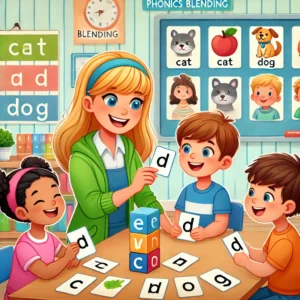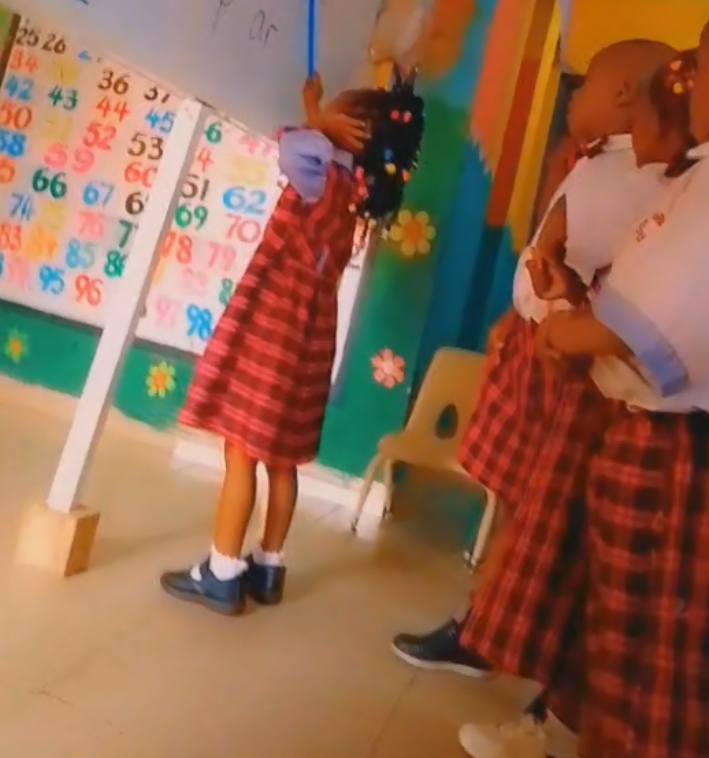Phonics Blending Activities for Nursery 2

Introduction
Teaching phonics blending in Nursery 2 is an exciting step toward early reading skills. Blending helps children combine individual letter sounds to form words, improving their fluency and pronunciation.
This guide provides fun phonics blending activities that will make learning enjoyable for your pupils.
What is Phonics Blending?
Phonics blending is the process of combining individual letter sounds (phonemes) to form words. For example:
✅ /c/ + /a/ + /t/ = cat
✅ /d/ + /o/ + /g/ = dog
It is a crucial skill for reading and spelling success.
Fun and Simple Phonics Blending Activities for Nursery 2
1️⃣ Sound Hopscotch
Materials: Chalk (for outdoor play) or a large paper grid
How to Play:
-
Draw a hopscotch grid with letters instead of numbers (e.g., C, A, T).
-
A child jumps on each letter while saying its sound.
-
Once they reach the last letter, they blend the sounds together to form a word.
✅ Learning Outcome: Improves letter recognition and sound blending through movement.
2️⃣ Mystery Bag of Sounds
Materials: A small bag, letter flashcards
How to Play:
-
Place letter flashcards inside a bag.
-
A child picks three letters (e.g., B, A, T).
-
They sound out each letter, then blend them together to form a word.
✅ Learning Outcome: Encourages sound awareness and hands-on learning.
3️⃣ Phonics Train
Materials: Paper train cutouts, marker
How to Play:
-
Write a CVC word (Consonant-Vowel-Consonant) on train carriages (e.g., C-A-T).
-
Ask children to read each letter separately, then blend them together as the train moves.
✅ Learning Outcome: Reinforces blending skills and word recognition.
4️⃣ Clap and Blend
Materials: None
How to Play:
-
Say a simple word like “dog” but break it into sounds: /d/ – /o/ – /g/.
-
Have children clap for each sound.
-
Say the word normally, and let them repeat after you.
✅ Learning Outcome: Strengthens listening skills and sound blending ability.
5️⃣ Word Puzzle Match
Materials: Word flashcards, scissors
How to Play:
-
Write simple words on flashcards and cut them into separate letters.
-
Shuffle the pieces and ask children to put them together in the correct order.
✅ Learning Outcome: Develops problem-solving skills and letter-sound connection.
6️⃣ Spin and Blend Game
Materials: A spinning wheel with letters
How to Play:
-
Spin the wheel to land on a letter.
-
Say the letter sound.
-
Spin again until you form a complete word, then blend the sounds.
✅ Learning Outcome: Makes learning interactive and fun.
7️⃣ Singing Phonics Blends
Materials: None
How to Play:
-
Use familiar tunes to teach blending, e.g., Old MacDonald.
-
Example:
-
C-A-T, that spells CAT, meow meow!
-
D-O-G, that spells DOG, woof woof!
-
✅ Learning Outcome: Improves memory retention and pronunciation.
8️⃣ Pop the Balloon
Materials: Balloons, marker
How to Play:
-
Write different letters on balloons.
-
Call out a word and ask the child to pop the correct letter sounds.
✅ Learning Outcome: Builds quick thinking and letter recognition.
FAQs (Frequently Asked Questions)
❓ What is the best way to teach phonics blending to Nursery 2 kids?
➡️ Use hands-on activities like sound hopscotch, phonics trains, and songs.
❓ Why is phonics blending important?
➡️ It helps children read fluently by connecting letter sounds to form words.
❓ How can I make phonics fun for my pupils?
➡️ Incorporate games, music, and movement to keep them engaged.
❓ What are some simple CVC words for blending practice?
➡️ Words like cat, dog, bat, sun, net, run, hop, sit, red, pot.
❓ How long should phonics lessons be for Nursery 2 pupils?
➡️ 15-20 minutes per session to match their attention span.
❓ At what age should a child start phonics blending?
➡️ Around 3-4 years old, depending on the child’s readiness.
❓ What materials do I need for phonics blending activities?
➡️ Flashcards, letter blocks, picture charts, and interactive games.
❓ How do I assess phonics blending progress?
➡️ Ask children to read new words aloud and check their pronunciation.
❓ Can phonics blending help struggling readers?
➡️ Yes! It builds confidence and improves reading speed.
❓ What should I do if a child struggles with blending?
➡️ Slow down, use simpler words, and give extra practice with songs and games.
Conclusion
Teaching phonics blending to Nursery 2 pupils can be fun and interactive with the right activities. Using games, songs, movement, and hands-on exercises, you can help young learners develop strong reading skills while keeping them engaged.
Phonics Blending Activities for Nursery 2 – Answers and Explanations
Teacher: “Alright, class! Let’s check our answers and see who got them right. And if you gave a funny answer, we’ll correct it together. Let’s go!”
1. The process of joining individual letter sounds to form a word is called ______.
✅ Answer: b) Blending
Emeka: “It’s called sound-wedding!”
Aisha: “No, Miss Emily! It’s blending!”
Teacher: “Great job, Aisha! Emeka, that’s funny! But in phonics, we call it blending, not a wedding.”
2. The word ‘cat’ is blended as ______.
✅ Answer: a) /k/ – /a/ – /t/
Bolu: “I say ‘cat’ as ‘meow’!”
Teacher: “That’s how a cat sounds! But when we read, we say the sounds separately: /k/ – /a/ – /t/.”
3. In the word ‘dog’, the middle vowel sound is ______.
✅ Answer: c) /o/
Maryam: “The middle sound is woof!”
Teacher: “Dogs say ‘woof,’ but when we spell, the middle sound in ‘dog’ is /o/.”
4. The word ‘bat’ is made up of ______ sounds.
✅ Answer: c) Three
David: “Bat has one sound: flapping wings!”
Teacher: “Haha! A real bat flaps, but the word ‘bat’ has three sounds: /b/, /a/, and /t/.”
5. Which of these is a correct CVC word?
✅ Answer: a) Sat
Chiamaka: “Tree is CVC because trees have branches!”
Teacher: “Nice thinking! But ‘tree’ is not CVC because it has four letters and two vowels.”
6. In phonics blending, the first sound in ‘sun’ is ______.
✅ Answer: a) /s/
Tunde: “The first sound in ‘sun’ is hot!”
Teacher: “Haha! The sun is hot, but in phonics, we listen to sounds. The first sound is /s/.”
7. The word ‘run’ can be blended as ______.
✅ Answer: c) /r/ – /u/ – /n/
Ibrahim: “I thought it was /n/ – /r/ – /u/!”
Teacher: “Not quite, Ibrahim. We start with the first letter, so it’s /r/ – /u/ – /n/.”
8. Which of these is an activity that helps children with phonics blending?
✅ Answer: b) Singing songs
Zainab: “Playing football?”
Teacher: “Football is fun, but for phonics, we use songs to practice sounds!”
9. The vowel sound in the word ‘net’ is ______.
✅ Answer: b) /e/
Uche: “The vowel sound is /t/!”
Teacher: “Close! The vowel sound is in the middle. In n-e-t, the vowel is /e/.”
10. In the game ‘Sound Hopscotch’, children jump on letters and say their ______.
✅ Answer: c) Sounds
Femi: “We say our shoe size!”
Teacher: “That would be funny, but no! We jump and say the letter sounds.”
11. A fun way to practice phonics blending is by using ______.
✅ Answer: a) Letter flashcards
Blessing: “I think we should use a football.”
Teacher: “Football is great for sports, but for phonics, flashcards help us read better.”
12. The word ‘big’ is made up of ______ consonant sounds.
✅ Answer: b) Two
Tope: “Only one because ‘big’ is big!”
Teacher: “Haha! But let’s look at the sounds: b and g are consonants, so there are two.”
13. Which of these words is NOT a CVC word?
✅ Answer: d) Rain
Michael: “Rain is not a word, it’s water from the sky!”
Teacher: “Rain is water, yes! But in phonics, ‘rain’ has two vowels, so it’s not CVC.”
14. The letter ‘B’ makes the sound ______.
✅ Answer: b) /b/
Tomi: “I thought it was /m/!”
Teacher: “No, Tomi. M makes /m/, but B makes /b/, like in ball.”
15. A child struggling with phonics blending should ______.
✅ Answer: b) Practice more with fun activities
Segun: “They should stop reading!”
Teacher: “No, Segun! If we find something hard, we practice more to get better.”
Final Thought
Teacher: “Great job, everyone! We learned a lot today. If you got any wrong, don’t worry—just keep practicing and soon, you’ll be a phonics blending superstar!”
